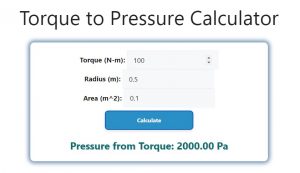About Torque to Pressure Calculator (Formula)
The Torque to Pressure Calculator is a useful tool in mechanical engineering that helps professionals convert torque values into pressure. This conversion is essential in various applications, such as hydraulic systems, machinery, and automotive engineering, where understanding the relationship between torque and pressure is crucial for proper design and operation. By utilizing this calculator, engineers can ensure that systems operate safely and efficiently, minimizing the risk of equipment failure.
Formula
The formula for calculating pressure from torque is:
Pressure = Torque / (Radius * Area)
Where:
- Pressure is the output in appropriate units (e.g., Pascals, psi).
- Torque is the input measured in units like Newton-meters (Nm) or foot-pounds (ft-lb).
- Radius refers to the distance from the center of rotation to the point where the force is applied, typically in meters or inches.
- Area is the cross-sectional area where the force is applied, usually in square meters or square inches.
How to Use
Using the Torque to Pressure Calculator is simple. Follow these steps:
- Gather Required Values: Obtain the torque value, radius, and area relevant to your calculation.
- Input Values: Enter the torque, radius, and area into the corresponding fields in the calculator.
- Calculate Pressure: Click the calculate button to determine the pressure resulting from the given torque.
Example
Let’s consider an example where we have the following values:
- Torque: 100 Nm
- Radius: 0.5 m
- Area: 0.1 m²
Using the formula:
Pressure = Torque / (Radius * Area)
Pressure = 100 / (0.5 * 0.1)
Pressure = 100 / 0.05
Pressure = 2000 Pa
In this example, the resulting pressure is 2000 Pascals.

FAQs
- What is a Torque to Pressure Calculator?
It is a tool that converts torque measurements into pressure values based on radius and area. - Why is this calculation important?
It helps in understanding the relationship between torque and pressure in mechanical systems. - What units are used for torque in this calculation?
Torque can be measured in Newton-meters (Nm) or foot-pounds (ft-lb). - Can I use this calculator for any type of machinery?
Yes, it is applicable in various mechanical and hydraulic systems. - What if I don’t know the area?
You must calculate or estimate the cross-sectional area where the force is applied. - Is pressure calculated in Pascals?
Yes, the pressure is typically calculated in Pascals (Pa), but it can also be converted to psi or other units. - What is the significance of radius in the calculation?
The radius affects how torque translates into pressure; a larger radius results in lower pressure for the same torque. - Can the torque value be negative?
Yes, negative torque can indicate a reversal of direction but ensure to consider its implications in the system. - How does temperature affect torque and pressure?
Temperature can affect the viscosity of fluids and the properties of materials, thus impacting torque and pressure readings. - Is there a limit to the values I can input?
While there’s no strict limit, ensure that the values are within realistic and safe operating ranges for your system. - How often should I use this calculator?
Use it whenever you need to evaluate changes in torque or design new mechanical systems. - Can this calculator be used for fluid dynamics?
Yes, it is applicable in fluid dynamics, especially in hydraulic systems where torque and pressure are relevant. - What if I change the radius?
Changing the radius will affect the calculated pressure; it’s essential to consider this in design and analysis. - How does this relate to hydraulic systems?
In hydraulic systems, torque and pressure are directly related to the performance of hydraulic motors and pumps. - Can this calculator help in torque wrench settings?
Yes, understanding the torque-to-pressure relationship can aid in setting appropriate torque wrench values for assembly. - Is there a recommended range for radius?
Use dimensions relevant to your specific application, ensuring they are realistic for your machinery. - What safety considerations should I keep in mind?
Always consider the operating limits of your equipment to avoid failures or accidents due to excessive pressure or torque. - Can I use this calculator for automotive applications?
Yes, it is commonly used in automotive engineering to relate engine torque to pressure in systems. - How precise do my input values need to be?
The precision of your inputs can affect the output; use as accurate values as possible for better results. - Where can I find the Torque to Pressure Calculator?
Many engineering websites and software offer Torque to Pressure calculators for easy access.
Conclusion
The Torque to Pressure Calculator is an essential tool for engineers and mechanics involved in the design and analysis of mechanical systems. By understanding the relationship between torque, radius, and area, users can convert torque values into pressure, ensuring safe and efficient operation. This calculator aids in various applications, including hydraulic systems and machinery, facilitating informed decision-making in engineering practices.